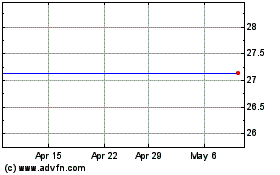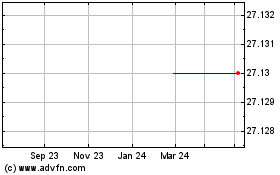Fortescue Metals Cuts Debt -- Update
October 15 2015 - 2:30AM
Dow Jones News
By Rhiannon Hoyle
SYDNEY-- Fortescue Metals Group Ltd. has been snapping up
bundles of its debt from the U.S. bond market, and executives say
they may acquire more for as long as the Australian miner can buy
it back cheaply.
An aggressive push to pay down its multibillion-dollar debt pile
ahead of schedule stalled this year after a sharp downturn in the
price of iron ore, the only commodity it sells and the value of
which has plunged 60% since the start of 2014. However, the miner
says sharp reductions in its operating costs have bolstered margins
and helped it resume that endeavor to reduce its indebtedness.
On Thursday, Fortescue said it had bought back US$384 million of
debt on-market since June, at an average price of 80 cents on the
dollar.
"If the market is going to price our debt at those levels, then
we are going to buy it," said Chief Executive Nev Power. Fortescue
shares closed more than 6% higher on Thursday.
In its decadelong quest to break the dominance of Vale SA, Rio
Tinto PLC and BHP Billiton Ltd. in iron-ore production, Fortescue
borrowed to build a vast network of landholdings, power and water
infrastructure, and railway and port facilities in Australia's
iron-rich Pilbara region.
Fortescue nearly came apart as iron-ore prices tumbled from
their 2011 record of above US$190 a metric ton, squeezing margins
just as it was ramping up production. It began speeding up bond
repayments two years ago as investors fretted about the miner's
huge debt burden, although a fall in ore prices to a decade low
this year put the brakes on that strategy.
Earlier this year, Fortescue refinanced some of its debt,
accepting an eye-watering 9.75% interest rate on its newest bonds
to push out its earliest maturity to 2019 from 2017.
Chief Financial Officer Stephen Pearce said substantial cuts to
operating costs had given the miner enough spare cash to buy back
debt in recent months. Fortescue plans to cut costs in the year
through June by nearly as much as the two prior fiscal years
combined, as the miner steps up its defense against the slumping
iron-ore price.
The miner said its net debt stood at US$6.6 billion at the end
of September, from a peak of US$11.3 billion in 2013.
The latest US$384-million cut to its debt pile will also result
in annual interest savings of US$33 million, said Fortescue, now
the world's fourth-biggest exporter of the steelmaking
commodity.
Any reduction in costs is a positive for the miner, as analysts
predict the price of iron ore may fall further later this
year--largely on rising supplies, including from billionaire Gina
Rinehart's new 55-million-ton-a-year Roy Hill mine in Pilbara. BHP
and Rio Tinto are also producing more.
Fortescue's goal is to reduce its gearing, a measure of debt to
equity, to 40%, from about 56% as of the middle of this year. Mr.
Pearce said that would take another US$2 billion in repayments to
achieve.
He stopped short of setting a timeline for that target. "Whether
it takes 12 months or 18 months...what is important is our
commitment to do it," he said.
Iron-ore prices have slumped amid fears that rising supply of
the raw material would overwhelm demand as China's economy
slows.
Fortescue has tripled its own production of the commodity in
recent years, although on Thursday the company said it shipped 41.9
million tons in the three months through September, marginally
below the 42.4 million tons it exported the quarter immediately
prior. The company said demand for its iron ore "remains strong,
despite the softening of steel markets in China."
Speaking at a forum in Sydney, also on Thursday, Rio Tinto
technology and innovation executive Greg Lilleyman also expressed
confidence in the outlook for iron ore and steel, saying the miner
expects "slower but higher-quality growth" in China to drive
demand. He forecast economic growth in China, the world's top
steelmaker, to decline to between 4-5% on average until 2030, from
roughly 7% now.
"But let's keep this in mind: in the next 15 years China will go
from being the second largest economy in the world to the largest,
effectively doubling its economy from its current base," Mr.
Lilleyman said in prepared remarks, adding that the country would
continue to need steel as more of its population shifts to urban
centers.
Write to Rhiannon Hoyle at rhiannon.hoyle@wsj.com
Subscribe to WSJ: http://online.wsj.com?mod=djnwires
(END) Dow Jones Newswires
October 15, 2015 02:15 ET (06:15 GMT)
Copyright (c) 2015 Dow Jones & Company, Inc.
Fortescue Metals (ASX:FMGCD)
Historical Stock Chart
From Mar 2024 to Apr 2024

Fortescue Metals (ASX:FMGCD)
Historical Stock Chart
From Apr 2023 to Apr 2024
